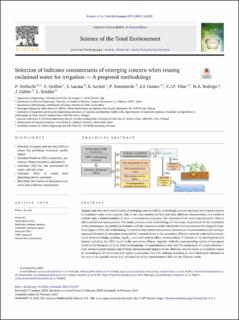| dc.description.abstract | Organic and microbial contaminants of emerging concern (CECs), even though not yet regulated, are of great concern in reclaimed water reuse projects. Due to the large number of CECs and their different characteristics, it is useful to include only a limited number of them in monitoring programs. The selection of the most representative CECs is still a current and open question. This study presents a new methodology for this scope, in particular for the evaluation of the performance of a polishing treatment and the assessment of the risk for the environment and the irrigated crops. As to organic CECs, the methodology is based on four criteria (occurrence, persistence, bioaccumulation and toxicity) expressed in terms of surrogates (respectively, concentrations in the secondary effluent, removal achieved in conventional activated sludge systems, Log Kow and predicted-no-effect concentration). It consists of: (i) development of a dataset including the CECs found in the secondary effluent, together with the corresponding values of surrogates found in the literature or by in-field investigations; (ii) normalization step with the assignment of a score between 1 (low environmental impact) and 5 (high environmental impact) to the different criteria based on threshold values set according to the literature and experts' judgement; (iii) CEC ranking according to their final score obtained as the sum of the specific scores; and (iv) selection of the representative CECs for the different needs.
Regarding microbial CECs, the selection is based on their occurrence and their highest detection frequency in the secondary effluent and in the receiving water, the antibiotic consumption patterns, and recommendations by national and international organisations.
The methodology was applied within the ongoing reuse project SERPIC resulting in a list of 30 indicator CECs, including amoxicillin, bisphenol A, ciprofloxacin, diclofenac, erythromycin, ibuprofen, iopromide, perfluorooctane sulfonate (PFOS), sulfamethoxazole, tetracycline, Escherichia coli, faecal coliform, 16S rRNA, sul1, and sul2. | en_US |

